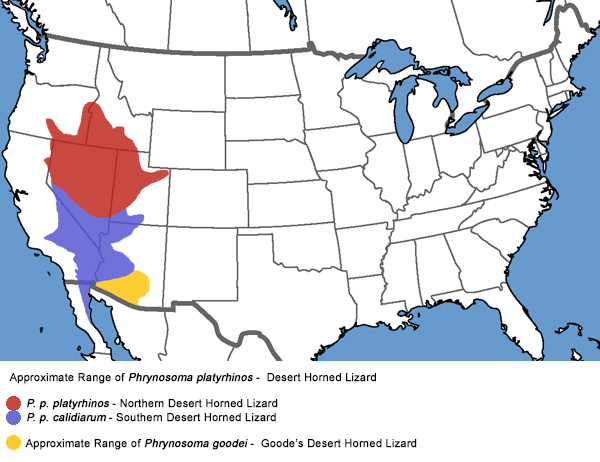Desert Horned Lizard - Phrynosoma platyrhinos
Southern Desert Horned Lizard - Phrynosoma platyrhinos calidiarum
Cope, 1896(= Doliosaurus platyrhinos calidiarum)
Description • Taxonomy • Species Description • Scientific Name • Alt. Names • Similar Herps • References • Conservation Status
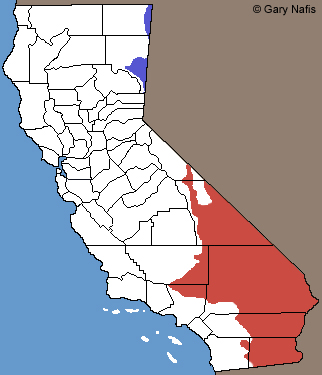
Phrynosoma platyrhinos calidiarum -
Southern Desert Horned Lizard
Range of other subspecies in California:
Dark Blue: Phrynosoma platyrhinos platyrhinos -
Northern Desert Horned Lizard
Click on the map for a topographical view
Map with California County Names
 |
 |
||||||||||||||||||||||||||||||||||||||||||||||||||||||
| Adult, Inyo County | Adult, San Bernardino County | ||||||||||||||||||||||||||||||||||||||||||||||||||||||
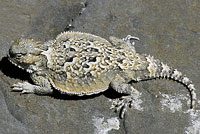 |
 |
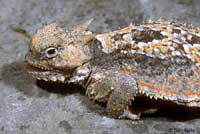 |
 |
||||||||||||||||||||||||||||||||||||||||||||||||||||
| Adult, Inyo County | Adult, San Bernardino County | Adult, Inyo County | Adult, Inyo County | ||||||||||||||||||||||||||||||||||||||||||||||||||||
 |
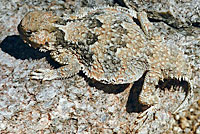 |
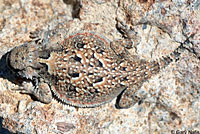 |
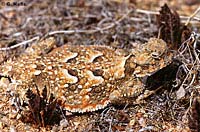 |
||||||||||||||||||||||||||||||||||||||||||||||||||||
| Adult, Kern County | Adult, San Bernardino County | Adult, Kern County | Adult, Kern County | ||||||||||||||||||||||||||||||||||||||||||||||||||||
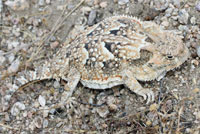 |
 |
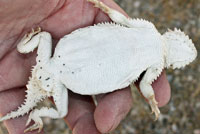 |
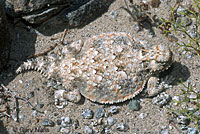 |
||||||||||||||||||||||||||||||||||||||||||||||||||||
| Adult male, Kern County | Adult, San Diego County | ||||||||||||||||||||||||||||||||||||||||||||||||||||||
 |
 |
 |
 |
||||||||||||||||||||||||||||||||||||||||||||||||||||
| Adult, Kern County | Adult, Kern County | Mono County © Keith Condon | Mono County © Keith Condon | ||||||||||||||||||||||||||||||||||||||||||||||||||||
 |
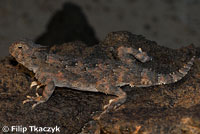 |
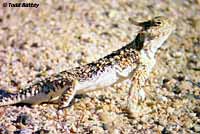 |
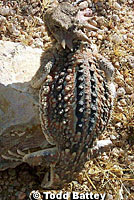 |
||||||||||||||||||||||||||||||||||||||||||||||||||||
| Horned Lizards in lava rock habitat tend to have dark coloring to match the dark soil, as you can see on this adult from San Bernardino County. (Both are the same lizard; the picture on the right was taken with flash.) © Filip Tkaczyk | Adult, Kern County © Todd Battey |
Striped adult, Kern County © Todd Battey |
|||||||||||||||||||||||||||||||||||||||||||||||||||||
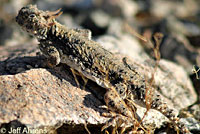 |
 |
 |
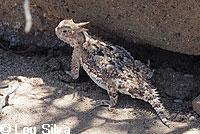 |
||||||||||||||||||||||||||||||||||||||||||||||||||||
| Adult, San Bernardino County © Jeff Ahrens | Adult, Kern County © Lou Silva | ||||||||||||||||||||||||||||||||||||||||||||||||||||||
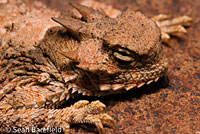 |
 |
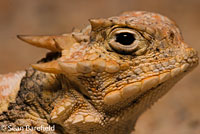 |
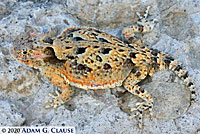 |
||||||||||||||||||||||||||||||||||||||||||||||||||||
| Close-ups of adults found in San Barnardino County © Sean Barefield | Adult female in yellow/orange color phase, Mono County © Adam G. Clause |
||||||||||||||||||||||||||||||||||||||||||||||||||||||
 |
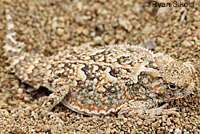 |
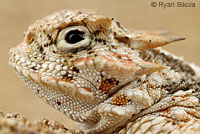 |
 |
||||||||||||||||||||||||||||||||||||||||||||||||||||
| Adult, Riverside County © Huck Triggs | Adult, Inyo County © Ryan Sikola | Adult, eastern San Bernardino County desert © Joel A. Germond | |||||||||||||||||||||||||||||||||||||||||||||||||||||
 |
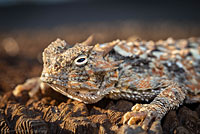 |
 |
 |
||||||||||||||||||||||||||||||||||||||||||||||||||||
| Adult, Inyo County © Grigory Heaton | Adult, San Bernardino County © Zeev Nitzan Ginsburg |
Close-up of the front of the head of an adult, San Bernardino County, with closed nasal valves. Horned lizards can close their nasal valves to keep soil from entering their nostrils and lungs when they bury themselves. The closed valves leave a small crescent-shaped opening through which the lizard can still breathe when it is buried. © Filip Tkaczyk |
Desert Horned lizards are covered with small granular scales interspersed with larger pointed scales on the dorsal surfaces. | ||||||||||||||||||||||||||||||||||||||||||||||||||||
| Juveniles | |||||||||||||||||||||||||||||||||||||||||||||||||||||||
 |
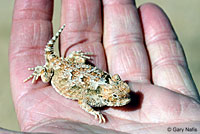 |
 |
 |
||||||||||||||||||||||||||||||||||||||||||||||||||||
| Juvenile, basking on a low rock in the early morning, Kern County | Juvenile, Kern County | Juvenile, Kern County | Juvenile, Kern County | ||||||||||||||||||||||||||||||||||||||||||||||||||||
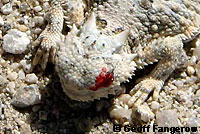 |
 |
 |
|||||||||||||||||||||||||||||||||||||||||||||||||||||
| Juvenile, eastern Riverside County © Geoff Fangerow When threatened, horned lizards will sometimes squirt blood from the eyes to deter predators, as this one did. |
Neonate, Kern County. © Todd Battey | Juvenile, San Bernardino County © Jeff Ahrens |
|||||||||||||||||||||||||||||||||||||||||||||||||||||
| Breeding Behavior | |||||||||||||||||||||||||||||||||||||||||||||||||||||||
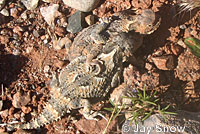 |
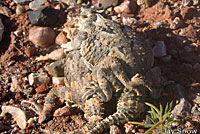 |
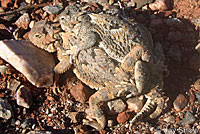 |
 |
||||||||||||||||||||||||||||||||||||||||||||||||||||
 |
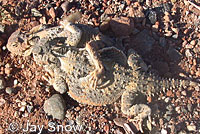 |
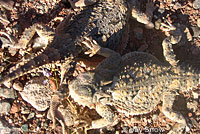 |
 |
||||||||||||||||||||||||||||||||||||||||||||||||||||
| Jay Snow shot this series (left to right, top to bottom) of a mating pair of Desert Horned Lizards one day in late May in Death Valley National Park. © Jay Snow |
|||||||||||||||||||||||||||||||||||||||||||||||||||||||
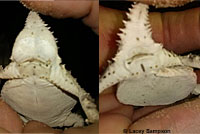 |
|||||||||||||||||||||||||||||||||||||||||||||||||||||||
| Male vent on left Female vent on right © Lacey Sampson |
|||||||||||||||||||||||||||||||||||||||||||||||||||||||
| Predators | |||||||||||||||||||||||||||||||||||||||||||||||||||||||
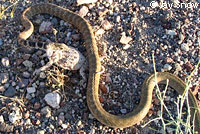 |
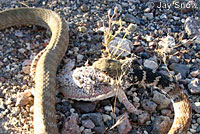 |
 |
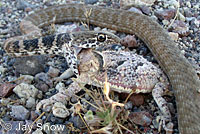 |
||||||||||||||||||||||||||||||||||||||||||||||||||||
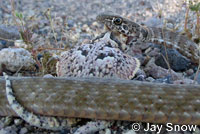 |
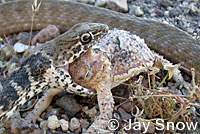 |
 |
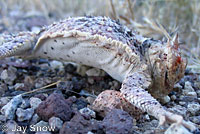 |
||||||||||||||||||||||||||||||||||||||||||||||||||||
| Jay Snow took this series (left to right, top to bottom) of a Red Racer trying to eat a live Southern Desert Horned Lizard over a period of 44 minutes. The snake failed to swallow the lizard and crawled away. In the last picture you can see that the lizard lay prone for several minutes after the coachwhip left then took up to 15 minutes to clean the saliva off its face before slowly walking away, no doubt thankful for the row of horns behind its head. © Jay Snow |
|||||||||||||||||||||||||||||||||||||||||||||||||||||||
| Comparison of Blainville's Horned Lizard with Desert Horned Lizard (from Stebbins, 2003) | |||||||||||||||||||||||||||||||||||||||||||||||||||||||
 |
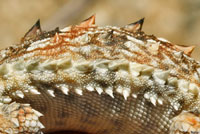 |
 |
|||||||||||||||||||||||||||||||||||||||||||||||||||||
| Blainville's Horned Lizards have 2 rows of pointed fringe scales on the lower part of each side of the body. |
|||||||||||||||||||||||||||||||||||||||||||||||||||||||
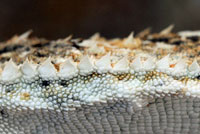 |
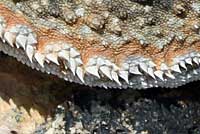 |
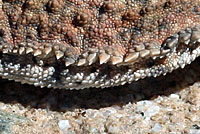 |
|||||||||||||||||||||||||||||||||||||||||||||||||||||
| Desert Horned Lizards have only 1 row of fringe scales on each side of the body | |||||||||||||||||||||||||||||||||||||||||||||||||||||||
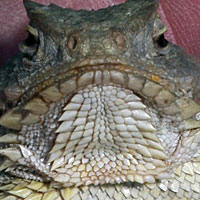 |
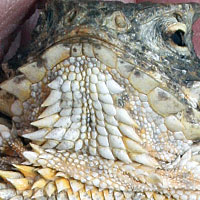 |
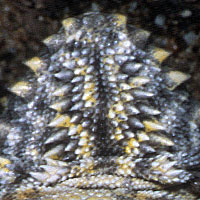 |
|||||||||||||||||||||||||||||||||||||||||||||||||||||
| Blainville's Horned Lizards have 2 or 3 rows of enlarged pointed scales on each side of the throat. | |||||||||||||||||||||||||||||||||||||||||||||||||||||||
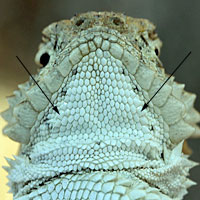 |
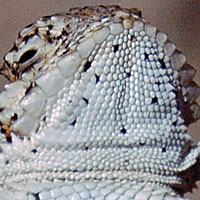 |
 |
|||||||||||||||||||||||||||||||||||||||||||||||||||||
| Desert Horned Lizards have only 1 row of slightly enlarged scales on each side of the throat. | |||||||||||||||||||||||||||||||||||||||||||||||||||||||
| Habitat | |||||||||||||||||||||||||||||||||||||||||||||||||||||||
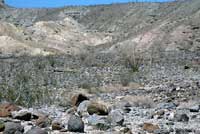 |
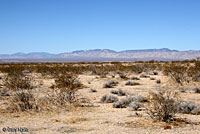 |
 |
 |
||||||||||||||||||||||||||||||||||||||||||||||||||||
| Adult in situ basking on a rock, San Diego County |
Habitat, Kern County | Habitat, Inyo County | Habitat, Inyo County | ||||||||||||||||||||||||||||||||||||||||||||||||||||
 |
 |
 |
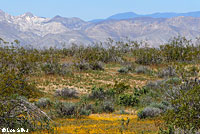 |
||||||||||||||||||||||||||||||||||||||||||||||||||||
| Habitat, San Bernardino County | Habitat, San Bernardino County | Habitat, Riverside County | Habitat in Spring, Kern County © Lou Silva |
||||||||||||||||||||||||||||||||||||||||||||||||||||
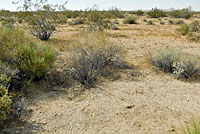 |
|||||||||||||||||||||||||||||||||||||||||||||||||||||||
| Lizard in habitat, Kern County | |||||||||||||||||||||||||||||||||||||||||||||||||||||||
| Short Video | |||||||||||||||||||||||||||||||||||||||||||||||||||||||
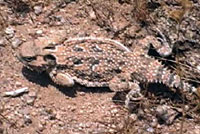 |
 |
s | |||||||||||||||||||||||||||||||||||||||||||||||||||||
| I found this horned lizard basking on a rock on a cool morning in the Mohave Desert. It only had two speeds - sit still and hide, and run away as fast as you can. | Walking around the Mohave Desert in Kern County one spring day I spotted several Desert Horned Lizards so I slowly followed them with my video camera hoping for some action. They did what they're designed to do - they ran in quick bursts a short distance, often under a bush, then they sat still hoping that their camouflage would make them invisible. | ||||||||||||||||||||||||||||||||||||||||||||||||||||||
|
|||||||||||||||||||||||||||||||||||||||||||||||||||||||
|
|||||||||||||||||||||||||||||||||||||||||||||||||||||||
|
The following conservation status listings for this animal are taken from the April 2024 State of California Special Animals List and the April 2024 Federally Listed Endangered and Threatened Animals of California list (unless indicated otherwise below.) Both lists are produced by multiple agencies every year, and sometimes more than once per year, so the conservation status listing information found below might not be from the most recent lists. To make sure you are seeing the most recent listings, go to this California Department of Fish and Wildlife web page where you can search for and download both lists: https://www.wildlife.ca.gov/Data/CNDDB/Plants-and-Animals. A detailed explanation of the meaning of the status listing symbols can be found at the beginning of the two lists. For quick reference, I have included them on my Special Status Information page. If no status is listed here, the animal is not included on either list. This most likely indicates that there are no serious conservation concerns for the animal. To find out more about an animal's status you can also go to the NatureServe and IUCN websites to check their rankings. Check the current California Department of Fish and Wildlife sport fishing regulations to find out if this animal can be legally pursued and handled or collected with possession of a current fishing license. You can also look at the summary of the sport fishing regulations as they apply only to reptiles and amphibians that has been made for this website. This animal is not included on the Special Animals List, which indicates that there are no significant conservation concerns for it in California. |
||
| Organization | Status Listing | Notes |
| NatureServe Global Ranking | ||
| NatureServe State Ranking | ||
| U.S. Endangered Species Act (ESA) | None | |
| California Endangered Species Act (CESA) | None | |
| California Department of Fish and Wildlife | None | |
| Bureau of Land Management | None | |
| USDA Forest Service | None | |
| IUCN | ||
|
|
||
Return to the Top
© 2000 -


